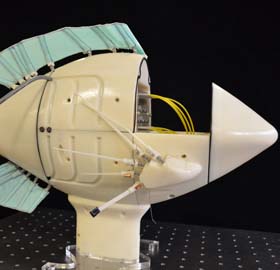Robotic Fish Research Receives NSF Funding

- Drexel Environmental Collaboratory Releases Cross-Sector Findings on Severe Weather Recovery Challenges
- Drexel Launches the Manuel Stamatakis Center for Alternative Investments at the LeBow College of Business
- How and When Could AI Be Used in Emergency Medicine?
- Drexel Receives $1.4 Million Grant to Establish Hub for Literacy Reform

A robotic fish, developed in Drexel University’s College of Engineering, could soon be leading the way for development of unmanned, automated marine vehicles according to researchers in the Laboratory for Biological Systems Analysis. Dr. James Tangorra, an assistant professor of mechanical engineering and mechanics, who heads the lab, is using the robotic fish model to understand the movement and sensory abilities of fish fins and attempting to translate this information into making more sophisticated marine systems for the Office of Naval Research.
“This grant provides us the opportunity to conduct detailed behavioral and neuromechanical studies of the fish and to use the results to inform the design of very advanced models of the fish’s propulsive and sensory systems,” said Tangorra.
Tangorra’s team will collaborate with Harvard University and the University of Chicago. The lab received $1.1 million for funding over the next three years from the ONR to take the next steps in understanding the multifunctional nature of rayed fish fins using behavioral observations, robotic and mathematical models.
The robotic fish, which is modeled after a bluegill fish, is being developed so that it can navigate through a complex environment using its fins both as a means for propulsion and sensing its surroundings and reacting accordingly.
“Although we’ve mainly considered the pectoral fin as a propulsive device, it’s highly likely that the fin is also a very sensitive sensory system. The pectoral fin has afferent nerves and free nerve endings throughout its webbing. We are investigating if these sensory nerves provide information that is used to make propulsion more effective and that helps the fish sense and interact with the water and other fish,” said Tangorra.
As this research progresses the ONR will use it to develop technology for its marine vehicles, with the goal of completing a unmanned, autonomous platform that could help advance naval capabilities in MCM, ASW, swimmer defense, surveillance and inspection and identification of hulls, harbors and piers.
Tangorra, who draws from his background as postdoctoral associate in MIT’s Bioinstrumentation Laboratory, focuses his work at Drexel on biorobotics, human performance and appropriate technology. His Laboratory for Biological Systems Analysis applies system level engineering techniques to biological systems to create biorobotic models, investigate hypotheses and evaluate functional performance of physiological systems in nature.
In This Article
Contact
Drexel News is produced by
University Marketing and Communications.